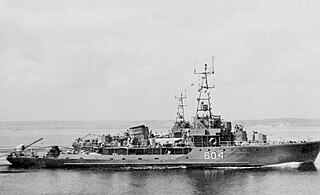
The LR5 is a crewed submersible which was used by the British Royal Navy until 2009 when it was leased to support the Royal Australian Navy. It is designed for retrieving sailors from stranded submarines and is capable of rescuing 16 at a time. The Royal Navy now has the use of the NATO Submarine Rescue System.

A deep-submergence rescue vehicle (DSRV) is a type of deep-submergence vehicle used for rescue of downed submarines and clandestine missions. While DSRV is the term most often used by the United States Navy, other nations have different designations for their vehicles.

The NATO Submarine Rescue System (NSRS) is a tri-national project to develop an international submarine rescue system. The system provides a rescue capability primarily to the partner nations of France, Norway and the United Kingdom, but also to NATO and allied nations and to any submarine equipped with a suitable mating surface around its hatches.
Australian Submarine Rescue Vehicle Remora was a submarine rescue vehicle used by the Royal Australian Navy (RAN) between 1995 and 2006. The name comes from the remora, a small fish that can attach itself to larger marine life, and has the backronym "Really Excellent Method of Rescuing Aussies".
The Type 072 is a class of tank landing ship in the People's Republic of China's People's Liberation Army Navy (PLAN). Seven were built and began entering service by the early-1980s. They replaced American-built LSTs from the Second World War.

The Type 903 is a class of replenishment oiler (AOR) built for the People's Liberation Army Navy by the People's Republic of China. They resemble HTMS Similan, an AOR built by China for Thailand and delivered in 1996.

The Type 067 is a class of utility landing craft (LCU) of the People's Republic of China's People's Liberation Army Navy (PLAN). Production ran from 1968 to 1972, possibly restarting by 1982, and ending in 1992.
The Type 068 and Type 069 are classes of landing craft mechanized (LCM) of the People's Republic of China's People's Liberation Army Navy (PLAN). They may be based on the Soviet T-4 landing craft, or smaller versions of the Type 067 landing craft with shorter tank and longer poop decks. The Type 068 and Type 069 were mainly designed to transport cargo and personnel respectively.

Qinghaihu is a Komandarm Fedko-class replenishment oiler of the People's Liberation Army Navy (PLAN). Ukraine sold the incomplete ship in 1992 to the People's Republic of China, where it was completed and commissioned in 1996.
The Type 925 Dajiang with NATO reporting name Dajiang, or 大江 in Chinese, meaning Great River, is a type of naval auxiliary ship belonging to the People's Republic of China. Each ship is usually equipped with up to two Type 7103 DSRV class Deep Submergence Rescue Vehicles (DSRVs). The ship is designed to replace the first People's Liberation Army Navy (PLAN) submarine tender PLANS Mount Tai, and the lead ship of the Dajiang class is the Changxingdao. The Type 925 is a submarine tender that can also be used as a submarine rescue ship, and hence, it is designated as a submarine support ship by Chinese.

The T43 were a class of open-ocean minesweepers built for the Soviet Navy from 1948 to 1957. It was exported to client states; the People's Republic of China and Poland produced additional ships. Some hulls were converted to other uses by various users. Examples remained in service in 2015.
The People's Republic of China developed a class of 35-ton deep-submergence rescue vehicle (DSRV) for the People's Liberation Army Navy (PLAN). It was first tested in 1986 and operational in 1989.

The Cheonghaejin class is a submarine rescue ship class of the Republic of Korea Navy. Only one ship has been built in the class, ROKS Cheonghaejin, in 1995. Its operations include rescuing trapped sailors in submarines, naval operation support for submarines, underwater research and mapping support, and recovery of sunk vessels. It is equipped with a deep submergence rescue vehicle (DSRV) that operates up to 500 metres (1,600 ft), and a rescue chamber that holds up to nine people.
The Chinese submarine with the hull number 201 is a Chinese diesel–electric auxiliary submarine. It is used to test systems and technologies, including test launching ballistic missiles (SLBM). 201 is the sole member of its class, designated Type 032.

The Type 905 is a class of replenishment oiler (AOR) built for the People's Liberation Army Navy (PLAN) by the People's Republic of China (PRC). They were the first ships built to perform underway replenishment in the PLAN.
The Hongqi-class or Hongqi 081-class cargo ship is a class of auxiliary ship in the People's Republic of China's People's Liberation Army Navy (PLAN). Seven entered PLAN service in the 1970s; the same design was also used for civilian ships.
Type 926 submarine support ship with NATO reporting name Dalao is a class of submarine rescue and supply ship developed by China for the People's Liberation Army Navy (PLAN), and as of mid-2014, a total of three are in service. This ship is capable of both replenishing submarines and rescuing submariners in distress.
The Tuzhong-class patrol ship is a class of oceangoing rescue and salvage ship in the People's Republic of China's China Coast Guard (CCG). Four were built at the Zhonghua Shipyard, and entered service with the People's Liberation Army Navy in the late-1970s. In 2009, each of the three fleets had one and the fourth was in reserve. In 2012, three were transferred to China Marine Surveillance and from there to the CCG.

JS Chiyoda was a submarine rescue ship of the Japan Maritime Self-Defense Force.

PNS Nasr (A47) is a Type 905 replenishment oiler of the Pakistan Navy. The oiler was constructed in the People's Republic of China by the Dalian Shipbuilding Industry Company and entered service in 1987.











